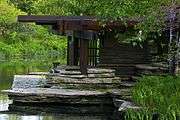Alfred Caldwell Lily Pool
|
Alfred Caldwell Lily Pool | |
 | |
| Location | Fullerton Parkway between Cannon and Stockton Drives in Lincoln Park, Chicago, IL |
|---|---|
| Architect | Alfred Caldwell |
| NRHP Reference # | 06000235[1] |
| Significant dates | |
| Added to NRHP | February 17, 2006 |
| Designated NHL | February 17, 2006 |
| Designated CL | November 6, 2002 |
Alfred Caldwell Lily Pool, also known as Lincoln Park Lily Pool, is an example of Prairie School landscape architecture designed by Alfred Caldwell and located at 125 W. Fullerton Parkway (between Stockton and Cannon Drives) in Lincoln Park, Chicago, Illinois. It was designated a Chicago Landmark on November 6, 2002.[2] It was listed on the National Register of Historic Places and as a National Historic Landmark on February 17, 2006.[3]
History
A Victorian-style artificially heated lily pool had originally been built in 1889 at the behest of Lincoln Park Commission Superintendent John Pettigrew to cultivate tropical water lilies .[4][5] The lilies proved hard to cultivate and maintain in the northern climate of Illinois and the pools became unsightly and were often considered "Pettigrew's frog ponds".[6] By the 1930s the hour-glass shaped pond and its environs had fallen into ruin and disrepair. Landscape architect Alfred Caldwell was hired by the Works Progress Administration to completely redesign this area of Lincoln Park.[5][7] Caldwell realized that the Lily Pool presented him with the unique opportunity to realize his poetic symbolism and design theories and philosophies.[8]
In 1938 the project was nearing completion and the park district decide to cut a major expenditure for wildflower plantings. Caldwell cashed in his $5000 life insurance policy for $250, bought thousands of plants and transported them from Sauk County, Wisconsin, and the next day planted them all around the lily pools with the help of four others.[9] [10]
Features
Caldwell had worked for landscape artist Jens Jensen from 1926 to 1931. Jensen's influence on Caldwell and the Lily Pool is evident in the Sun Opening or clearing, the curving walkways and meandering, stepping=stone limestone paths, and the circular benches that Jensen referred to as "the council ring" and "friendship circles" since there was no superior position to sit in. Frank Lloyd Wright's influence is represented in the organic architecture of the shelter and the Fullerton Parkway Gate, a prairie-style entryway into the property.[8]
The Rookery
In the early 1950s, under Zoo Director Marlin Perkins, the pool was transformed into a water exhibit featuring exotic birds and water fowl and came to be known as The Rookery. Overgrazing by zoo birds had a devastating effect on the lily pond. A lack of landscaping management allowing invasive plants and "weed" trees to take over the understory, heavy human foot traffic, uncontrolled erosion, the introduction of plants materials that were invasive to the existing lilies, and inappropriate repairs (eroded areas covered with loose stones) all resulted in what Caldwell called (in 1990) "a dead world. [9][11]
Renovation
From 1998 to 2002, the 2.7 acre Lily Pool underwent a major restoration by the Chicago Park District and the Lincoln Park Conservancy.
The Friends of Lincoln Park (now called The Lincoln Park Conservancy) raised $1.2 million toward the restoration of the lily pools. A similar sum was obtained from a grant from the USDA Forest Service. Wolff, Clements, and Associates, a firm of landscape architects, were hired to complete the project.
Five focus groups were conducted to develop a consensus plan for restoration of the site;[8]
- experts in historic preservation,
- bird watchers and ecologists,
- Individuals knowledgeable about Lincoln Park and active in its planning and management,
- activists and experts on the subject of accessibility,
- members of the general public.
The Chicago Park District and the Lincoln Park Conservancy manage a docent program at the Caldwell Lily Pool.[12]
Location
The Lily Pool's main gate is on the south side of Fullerton Parkway between Stockton and Cannon Drives (125 W Fullerton Parkway).[9]
The Lily Pool is open seasonally from mid-April to mid-November from 7:30 a.m. to the earlier of dusk or 7:30 p.m. It is maintained by the Chicago Park District and Lincoln Park Conservancy.
Free docent tours are available to the public on Fridays, Saturdays or Sundays from the Spring through Fall. [12]
| Gallery | ||||||
|---|---|---|---|---|---|---|
|
See also
References
- ↑ National Park Service (2007-01-23). "National Register Information System". National Register of Historic Places. National Park Service.
- ↑ "Alfred Caldwell Lily Pool". City of Chicago Department of Planning and Development, Landmarks Division. 2003. Retrieved June 16, 2010.
- ↑ "Lincoln Park Lily Pool". National Park Service. Retrieved May 10, 2007.
- ↑ "Lincoln Park Alfred Caldwell Lily Pool". Chicago Park District. 2006. Retrieved May 10, 2007.
- 1 2 NRHP Registration form 10-900
- ↑ Sniderman, Julia (1991). "Bringing the Prairie Vision into Focus". In Adams, Rosemary; Lamm Wood, Claudia. Prairie in the City: Naturalism in Chicago's Parks, 1870-1940. Chicago Historical Society. p. 129.
- ↑ Mark Rosenthal, et al., Ark in the Park (University of Illinois, 2003) p. 66.
- 1 2 3 "Concept Plan for the Rehabilitation of the Lily Pool". The Lily Pool. Chicago, IL: Friends of Lincoln Park.
- 1 2 3 Maloney, Cathy Jean (2008). Chicago Gardens:The Earliest History (first ed.). Chicago, Illinois: University of Chicago Press. p. 464. ISBN 9780-226-502-342.
- ↑ Grano, Laurie. "The Alfed Caldwell Lily Pool at Lincoln Park". gardendesign.com. Garden Design Magazine. Retrieved May 5, 2015.
- ↑ "Neglected Oasis to gain New Life When Zoo's Rookery is Renovated". chicagotribune.com. The Chicago Tribune. Retrieved May 5, 2015.
- 1 2 "Alfred Caldwell Lily pool Docent Training". chicagoparkdistrict.com. Chicago Park District. Retrieved May 5, 2015.
Coordinates: 41°55′31″N 87°38′03″W / 41.9253°N 87.6341°W
